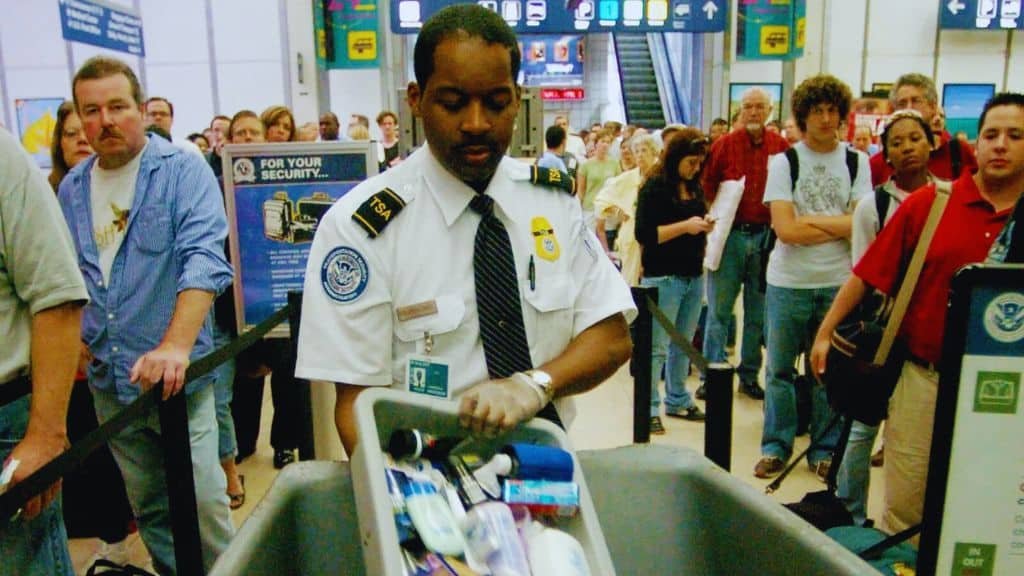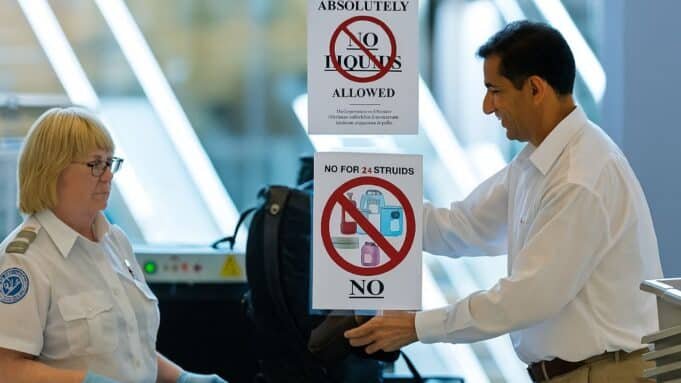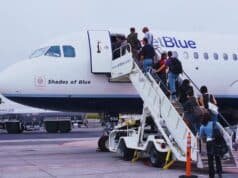TSA Liquid Carry on Restrictions Relax – For nearly two decades, U.S. air travelers have abided by the TSA’s strict 3-1-1 rule, which limits the amount of liquids passengers can carry in their hand luggage. The rule—3.4 ounces (100 milliliters) per container, all packed in a single quart-sized clear plastic bag—has long been a source of frustration.
Whether it’s tossing out an expensive bottle of lotion or trying to squeeze toiletries into mini-containers, the restriction has impacted millions of passengers daily.
However, significant change is on the horizon. The TSA has announced plans to relax these rules, thanks to advancements in scanning technology that offer greater accuracy and faster processing. This decision represents a major shift in airport security philosophy, aiming not only to maintain safety but also to enhance passenger convenience and streamline checkpoint operations.
The Origins and Impact of the 3-1-1 Rule
The 3-1-1 liquid rule was introduced in 2006 in response to a foiled terrorist plot involving liquid explosives on transatlantic flights. At the time, authorities feared that seemingly harmless liquids could be combined mid-flight to create deadly devices. In response, the U.S. and many other countries quickly imposed blanket bans on liquids, later refined into the 3-1-1 regulation.
This rule required travelers to rethink how they packed for flights. Full-size toiletries were out; travel-size items became the norm. The impact was broad: manufacturers produced mini versions of popular products, travelers adapted new packing habits, and airport security checkpoints became more complex and time-consuming. Despite frustrations, the rule effectively mitigated threats and became a symbol of heightened post-9/11 security.
TSA Liquid Carry On Restrictions Relax
What’s Changing: New TSA Guidelines on Liquids
The upcoming changes focus on allowing greater flexibility for liquids in carry-on bags, especially at airports equipped with advanced screening technology. Instead of the rigid 3.4-ounce limit, passengers at select security lanes may soon be allowed to carry full-size liquid containers.
This shift is enabled by the rollout of computed tomography (CT) scanners at airport checkpoints. These scanners provide detailed 3D images of bag contents, allowing security personnel to detect dangerous materials more precisely. As more airports integrate this technology, the TSA plans to test policies that loosen restrictions on liquid volumes, possibly removing the need for quart-sized bags altogether.
Travelers should note that the relaxed rules will initially apply only to lanes equipped with CT scanners. Airports will be rolling out these changes gradually, and until implementation is complete nationwide, the current rules may still apply in many locations.
Why Now? The Role of Technology in Security Transformation
The key driver of this change is the evolution of security technology. Traditional X-ray machines provided flat, two-dimensional views of baggage, making it harder to distinguish between benign and dangerous substances. CT scanners, on the other hand, produce high-resolution 3D images, enabling automated systems and human screeners to assess contents more accurately.
These scanners are already used in checked baggage screening, and their success in detecting threats has prompted their expansion into carry-on baggage checkpoints. In addition to improved safety, CT scanners are faster and reduce the need for manual bag inspections, leading to shorter wait times and less inconvenience for travelers.
This technological leap allows the TSA to shift focus from blanket volume limitations to a more nuanced, threat-based screening model, marking a modern era in aviation security.
Related Read: Can You Bring Hiking Poles on a Plane
What Travelers Stand to Gain
The relaxation of the 3-1-1 rule promises numerous benefits for passengers:
- Ease of Packing: Travelers will no longer have to buy travel-sized versions of their everyday products or squeeze liquids into tiny bottles. This change could be particularly beneficial for families, business travelers, and international tourists who prefer to carry their personal care items.
- Faster Screening Times: With fewer items being pulled for liquid checks and reduced need to unpack toiletries, security lines may move more efficiently.
- Less Stress: Eliminating the anxiety around packing liquids—worrying about quantities, leaks, or security confiscation—makes for a smoother travel experience overall.
- More Freedom for Special Needs: People with medical conditions, dietary needs, or traveling with infants often face difficulties with the 3-1-1 rule. A relaxed policy provides greater accommodation without excessive screening.
Limitations and Considerations
Despite the positive changes, travelers should remain cautious during the transition period:
- Inconsistent Implementation: Not all airports or lanes will immediately adopt the new rules. Some may still require compliance with the old 3-1-1 policy. Travelers should be prepared to follow the original guidelines unless they are certain a CT-equipped lane is in use.
- Potential Confusion: Without clear and consistent signage or communication, passengers might assume the rules have changed everywhere. This could lead to delays, repacking, or even the disposal of liquids at security.
- International Travel Variability: Other countries may not yet follow the same relaxed guidelines, so international travelers should still be aware of liquid restrictions at their departure and return destinations.
To navigate this period successfully, travelers are advised to check with their departure airport in advance or carry liquids in compliance with the traditional rule until the new standards are universally applied.
Reactions from Experts, Industry Leaders, and Passengers
Security experts generally support the move, praising it as a thoughtful evolution rather than a rollback. The combination of superior imaging and threat detection allows for a more intelligent security model. While some experts caution against a complete removal of liquid limits, most agree that technology provides the tools to safely ease restrictions without compromising security.
Airlines and airport authorities also support the change. Reduced screening times mean more efficient boarding, fewer delays, and improved customer satisfaction. For an industry constantly grappling with customer experience challenges, this development is a welcome improvement.
Passengers, especially frequent flyers and business travelers, have expressed enthusiasm. Many see this as a long-overdue modernization. It removes one of the most inconvenient aspects of air travel and aligns the U.S. with countries that have already relaxed similar restrictions.
Read: Can You Bring a Trekking Pole on a Plane?
Global Comparisons: How Other Countries Are Responding
The United States is not the first to explore rule changes in liquid form. The United Kingdom and several European countries have already begun transitioning to relaxed liquid policies, enabled by similar CT technology. Some airports in Europe allow travelers to carry liquids of up to 2 liters in their hand luggage if passing through enhanced screening lanes.
In Asia and the Middle East, major international hubs are closely watching these developments and beginning their pilot programs. Over time, this may lead to a more standardized global approach to carry-on liquids, making international travel smoother and less inconsistent for passengers.
Preparing for the Future: What to Expect Next

Travelers can expect a phased, methodical rollout of relaxed rules over the next few years. Major U.S. airports are prioritized for CT scanner installations, with smaller airports following. In the meantime, awareness and adaptability will be key.
Here’s how passengers can prepare:
- Stay Informed: Follow updates from the TSA and your local airport to stay informed about any new rules that may be in place.
- Pack Smart: If in doubt, continue to follow the 3-1-1 rule to avoid unnecessary delays.
- Look for CT Checkpoint Lanes: Some airports may label these lanes; choosing one can help you take advantage of the new policies.
- Provide Feedback: Passengers are encouraged to share their experiences with TSA or airport authorities to improve implementation.
What is the TSA 3-1-1 Liquid Rule?
The 3-1-1 rule is a security regulation established by the TSA in 2006. It stands for:
- 3.4 ounces (100 milliliters) per container.
- 1 quart-sized clear plastic bag for liquids.
- 1 bag per passenger, to be placed in carry-on luggage.
The rule was implemented to prevent liquid explosives from being brought aboard aircraft. It has been strictly enforced across all U.S. airports for nearly two decades.
Read Also: Can You Bring Cigarettes on a Plane?
Why is the TSA changing the liquid rule now?
The change is being driven by the introduction of CT (computed tomography) scanners at airport checkpoints. These scanners generate 3D images that allow TSA officers to analyze the contents of carry-on bags with greater precision. This technology significantly reduces the risk posed by liquids, making it possible to ease restrictions without compromising security.
Are the new rules in effect at all airports?
No, the relaxed rules are currently limited to specific TSA lanes equipped with CT scanners. These lanes are mostly available at larger airports. Travelers should not assume the rule has changed everywhere and should still pack liquids according to the 3-1-1 rule unless they are certain a CT-equipped lane is available.
What types of liquids will be allowed under the new policy?
While the exact policy is still being finalized, passengers in designated CT lanes will likely be able to carry:
- Full-size toiletries (e.g., shampoo, conditioner, body wash)
- Bottled water or beverages
- Creams, gels, and lotions
As long as the scanner confirms the contents are safe, the size restriction may not apply.
How can I find out if my airport uses CT scanners?
You can:
- Check the official website of your departure airport.
- Visit TSA’s official website for updates.
- Look for signs at security checkpoints indicating that CT scanners are in use.
- Ask TSA officers at the checkpoint if the liquid limits have been relaxed at that location.
What should I do if I’m unsure whether the new rules apply to my flight?
If you’re uncertain, the safest option is to pack your liquids according to the traditional 3-1-1 rule. This will help you avoid delays, repacking, or having your items discarded at the checkpoint. Only adjust your packing if you know you’ll be using a CT-equipped lane.
To Know More: Can You Bring Deodorant on a Plane
Will international airports also adopt these changes?
Several international airports, especially in the UK and Europe, have already begun implementing similar relaxations where CT scanners are in place. However, not all countries have adopted the same standards. If you’re flying internationally, check the liquid rules for both your departure and arrival airports.
Conclusion
The easing of TSA liquid carry on restrictions relax is more than just a convenience—it’s a milestone in the evolution of air travel security. By embracing advanced scanning technology, the TSA is enhancing safety while reducing the burden on travelers. This balanced, data-driven approach demonstrates how innovation can lead to smarter, more humane airport procedures.
While full implementation will take time, the future of air travel is undeniably more efficient and passenger-friendly. For millions of travelers, the days of cramming shampoo into tiny bottles may soon be a thing of the past.















